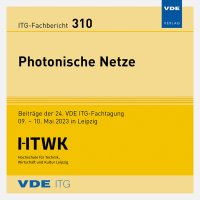Performance Comparison of Efficient Fiber Kerr Nonlinearity Mitigation Schemes in a Dispersion- Managed Link for 32 GBd 16-QAM Signals
Conference: Photonische Netze - 24. ITG-Fachtagung
05/09/2023 - 05/10/2023 at Berlin
Proceedings: ITG-Fb. 310: Photonische Netze
Pages: 5Language: englishTyp: PDF
Authors:
Dsilva, Vegenshanti; Moreno Morrone, Juan L.; Sackey, Isaac; Ronniger, Gregor; Fischer, Johannes Karl; Schubert, Colja (Fraunhofer Institute for Telecommunications, Heinrich-Hertz-Institute, Berlin, Germany)
von Huenefeld, Guillermo; Freund, Ronald (Fraunhofer Institute for Telecommunications, Heinrich-Hertz-Institute, Berlin, Germany & Technische Universität Berlin, Fachgebiet Photonische Kommunikationssysteme, Berlin, Germany)
Abstract:
Unifying optical and digital nonlinearity mitigation techniques has been shown to be a robust solution to overcome the limitations of the individual schemes. In this study, we implemented joint optical-digital fiber nonlinearity mitigation approaches that utilizes mid-link optical phase conjugation, in combination with digital-domain methods, namely digital backpropagation, recurrent neural network and reservoir computing network. The efficacy of the investigated nonlinearity mitigation approaches were evaluated on a single-channel 32 GBd single-polarization 16-QAM signal transmitted over an 800-km dispersion-managed link. In our realizations for fiber Kerr nonlinearity mitigation, we implemented one optical-domain nonlinearity mitigation scheme (i.e., optical phase conjugation) and three different digital-domain nonlinearity mitigation schemes (i.e., digital backpropagation, recurrent neural network, and reservoir computing network). To investigate the gain margins by joint optical-digital nonlinearity mitigation optimization, we initially utilized the mid-link optical phase conjugation to compensate for the nonlinear impairments and subsequently, the compensated signal was subjected to either of the digital-domain schemes. As expected, our findings demonstrated that the joint approach shows a superior performance than the individual schemes, with gains up to 1.3 dB with the uncompensated signal as a benchmark. We also present the results observed during optimization of the neural network-assisted techniques for hyper-parameters such as the number of input samples and the number of hidden layer neurons.


